Criteria of tests-4
- 格式:ppt
- 大小:551.50 KB
- 文档页数:32
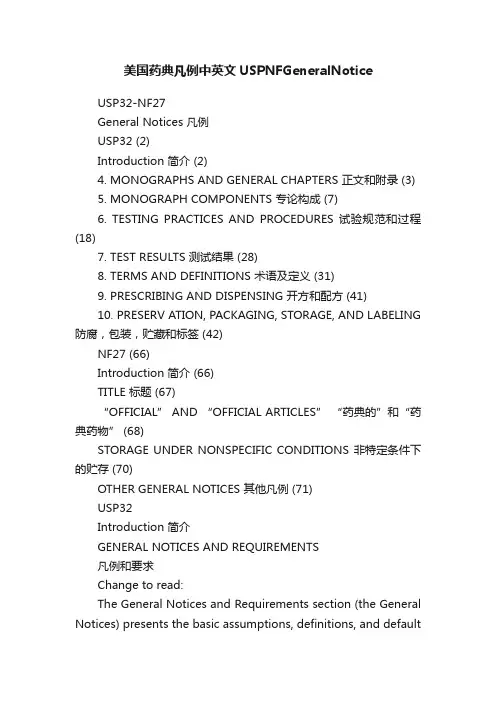
美国药典凡例中英文USPNFGeneralNoticeUSP32-NF27General Notices 凡例USP32 (2)Introduction 简介 (2)4. MONOGRAPHS AND GENERAL CHAPTERS 正文和附录 (3)5. MONOGRAPH COMPONENTS 专论构成 (7)6. TESTING PRACTICES AND PROCEDURES 试验规范和过程(18)7. TEST RESULTS 测试结果 (28)8. TERMS AND DEFINITIONS 术语及定义 (31)9. PRESCRIBING AND DISPENSING 开方和配方 (41)10. PRESERV ATION, PACKAGING, STORAGE, AND LABELING 防腐,包装,贮藏和标签 (42)NF27 (66)Introduction 简介 (66)TITLE 标题 (67)“OFFICIAL” AND “OFFICIAL ARTICLES” “药典的”和“药典药物” (68)STORAGE UNDER NONSPECIFIC CONDITIONS 非特定条件下的贮存 (70)OTHER GENERAL NOTICES 其他凡例 (71)USP32Introduction 简介GENERAL NOTICES AND REQUIREMENTS凡例和要求Change to read:The General Notices and Requirements section (the General Notices) presents the basic assumptions, definitions, and defaultconditions for the interpretation and application of the United States Pharmacopeia (USP) and the National Formulary (NF).凡例和要求部分(凡例)给出对USP和NF中假设、定义、默认条件的解释和应用。
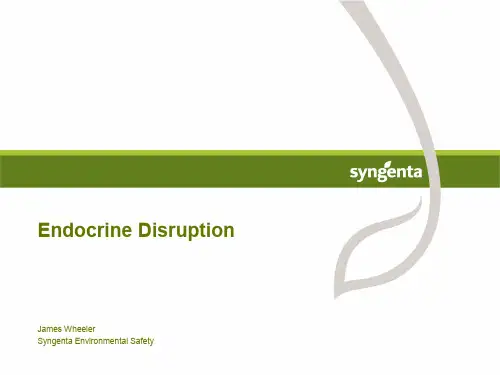

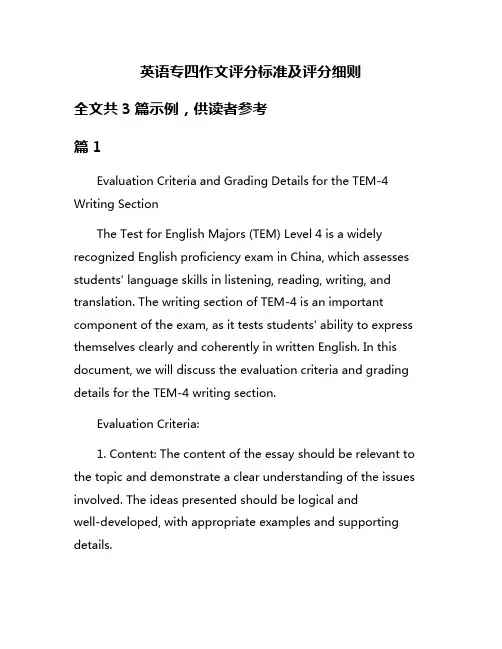
英语专四作文评分标准及评分细则全文共3篇示例,供读者参考篇1Evaluation Criteria and Grading Details for the TEM-4 Writing SectionThe Test for English Majors (TEM) Level 4 is a widely recognized English proficiency exam in China, which assesses students' language skills in listening, reading, writing, and translation. The writing section of TEM-4 is an important component of the exam, as it tests students' ability to express themselves clearly and coherently in written English. In this document, we will discuss the evaluation criteria and grading details for the TEM-4 writing section.Evaluation Criteria:1. Content: The content of the essay should be relevant to the topic and demonstrate a clear understanding of the issues involved. The ideas presented should be logical andwell-developed, with appropriate examples and supporting details.2. Organization: The essay should have a clear and coherent structure, with a well-defined introduction, body paragraphs, and conclusion. There should be smooth transitions between paragraphs and ideas, creating a cohesive and unified piece of writing.3. Language Use: The language used should be accurate and appropriate for academic writing. Students should demonstrate a good command of grammar, vocabulary, and sentence structure, as well as use a variety of sentence patterns and vocabulary to convey their ideas effectively.4. Argumentation: The essay should present a clear thesis statement and provide strong arguments to support it. The arguments should be persuasive and backed by evidence and examples, demonstrating critical thinking and analytical skills.5. Mechanics: The essay should be free of spelling, punctuation, and capitalization errors. It should also follow the conventions of academic writing, such as using appropriate paragraph and sentence lengths, as well as maintaining a formal tone throughout.Grading Details:Essays are typically graded on a scale of 1 to 100, with the following breakdown:1. Content (40 points): The essay will be evaluated based on the relevance and depth of the content, as well as the clarity and coherence of the ideas presented.2. Organization (20 points): The structure of the essay, including the introduction, body paragraphs, and conclusion, will be assessed for clarity and effectiveness.3. Language Use (20 points): Grammar, vocabulary, and sentence structure will be evaluated for accuracy and appropriateness, as well as the use of a variety of language features.4. Argumentation (10 points): The strength of the thesis statement, the persuasiveness of the arguments, and the use of evidence and examples will be considered in this category.5. Mechanics (10 points): Spelling, punctuation, and capitalization errors, as well as adherence to academic writing conventions, will be reviewed for this section.In conclusion, the writing section of the TEM-4 exam requires students to demonstrate their ability to communicate effectively and coherently in written English. By following theevaluation criteria and understanding the grading details, students can better prepare for this part of the exam and improve their chances of achieving a high score.篇2Scoring Criteria and Detailed Rules for CET-4 WritingIntroductionThe CET-4 (College English Test Level 4) writing section is an important component of the test, designed to assess students' ability to express themselves clearly and effectively in written English. In order to effectively evaluate and score students' writing, specific criteria and detailed rules have been established.Scoring Criteria1. Task Fulfillment: The essay must address the given topic and answer any questions or requirements specified in the prompt. Failure to fulfill the task may result in a lower score.2. Content and Development: The essay should have a clear and coherent structure, with well-developed ideas that are relevant to the topic. The content should be supported by appropriate examples and details.3. Organization: The essay should have a logical progression of ideas, with an introduction, body paragraphs, and a conclusion. The organization should be clear and easy to follow.4. Language Use: The essay should demonstrate a good command of grammar, vocabulary, and sentence structure. Errors in grammar and vocabulary will result in deductions.5. Mechanics: The essay should be free of spelling and punctuation errors. Formatting, such as paragraph breaks and indentation, should also be correct.6. Creativity and Originality: A well-written essay that demonstrates creativity, originality, and a unique perspective may receive a higher score.Detailed Rules1. Avoid plagiarism by citing sources properly and acknowledging any borrowed ideas or information.2. Use a variety of sentence structures, such as simple, compound, and complex sentences, to demonstrate a range of language skills.3. Pay attention to word choice and use precise and appropriate vocabulary to convey your ideas effectively.4. Use transitions to connect ideas and improve the flow of the essay.5. Proofread your essay carefully to correct any errors in grammar, spelling, or punctuation.6. Use paragraphs to organize your ideas and help the reader follow your argument.7. Use examples, evidence, and details to support your arguments and make your points more persuasive.ConclusionBy understanding the scoring criteria and following the detailed rules for writing, students can improve their performance on the CET-4 writing section. Practicing writing essays and receiving feedback can also help students strengthen their writing skills and achieve a higher score on the test.篇3English Proficiency Test (CET-4) Writing Assessment Criteria and Scoring DetailsThe College English Test (CET) is a standardized test of English language proficiency for college students in China. CET-4 is an essential part of the test, which assesses candidates'proficiency in English writing skills. In this article, we will discuss the assessment criteria and scoring details for the CET-4 writing section.Assessment Criteria:1. Content and Task Achievement: Candidates are required to demonstrate their ability to understand the topic, develop ideas coherently, and address the task effectively. The content should be relevant, well-developed, and supported by examples or evidence.2. Organization: Candidates should organize their writing logically, with a clear introduction, body paragraphs, and conclusion. Transitions between paragraphs should be smooth, and ideas should be presented in a coherent manner.3. Language Use: Candidates should demonstrate a good command of grammar, vocabulary, and sentence structure. Sentences should be varied in structure and length, with appropriate use of conjunctions, prepositions, and other linking words.4. Cohesion and Coherence: Candidates should use cohesive devices such as pronouns, conjunctions, and transitional wordsto connect ideas and create a smooth flow of writing. The text should be coherent and easy to follow.5. Register and Task-appropriateness: Candidates should use appropriate language register for the task, avoiding informal language and slang. The tone should be formal and appropriate for academic or professional writing.Scoring Details:The writing section of the CET-4 test is scored on a scale of 0-30 points. Each of the assessment criteria mentioned above contributes to the overall score as follows:- Content and Task Achievement: 10 points- Organization: 6 points- Language Use: 6 points- Cohesion and Coherence: 4 points- Register and Task-appropriateness: 4 pointsIn addition to the criteria mentioned above, candidates will also be assessed on their overall writing proficiency, including creativity, originality, and critical thinking skills.In conclusion, the CET-4 writing section assesses candidates' proficiency in English writing skills based on specific criteria such as content, organization, language use, cohesion, coherence, and task-appropriateness. By understanding the assessment criteria and scoring details, candidates can effectively prepare for the writing section of the CET-4 test and improve their chances of achieving a high score.。
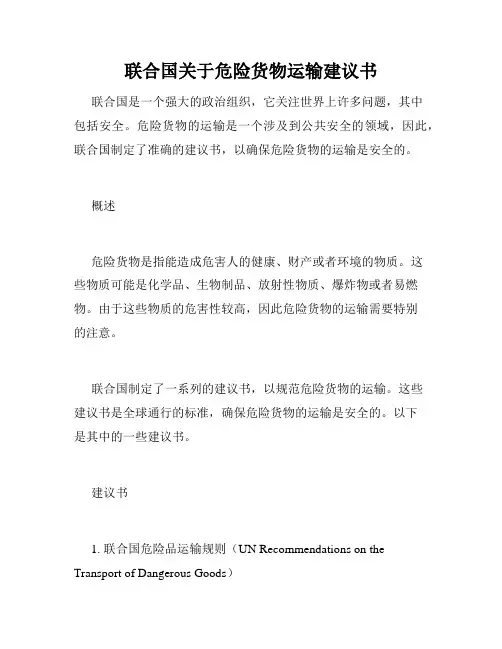
联合国关于危险货物运输建议书联合国是一个强大的政治组织,它关注世界上许多问题,其中包括安全。
危险货物的运输是一个涉及到公共安全的领域,因此,联合国制定了准确的建议书,以确保危险货物的运输是安全的。
概述危险货物是指能造成危害人的健康、财产或者环境的物质。
这些物质可能是化学品、生物制品、放射性物质、爆炸物或者易燃物。
由于这些物质的危害性较高,因此危险货物的运输需要特别的注意。
联合国制定了一系列的建议书,以规范危险货物的运输。
这些建议书是全球通行的标准,确保危险货物的运输是安全的。
以下是其中的一些建议书。
建议书1. 联合国危险品运输规则(UN Recommendations on the Transport of Dangerous Goods)这个建议书包括一组规则,涵盖了危险货物的所有方面:从包装到标记、从装卸到运输。
这些规则在全球范围内通行,并确保所有的危险货物运输都遵守国际标准。
2. 管理危险货物的安全(Managing the Safe Transport of Dangerous Goods)这个建议书专门阐述了危险货物的运输安全管理。
它包括了一些基本的原则,如规划、物流和紧急情况下的处理方法,以确保危险货物的运输安全。
3. 建议书7(Recommendations on the Transport of Dangerous Goods: Manual of Tests and Criteria)这个建议书是由联合国制定的标准,用于测试和评估危险货物的运输是否符合标准。
该建议书包括了一系列的测试方法和标准,以确保危险货物的运输是安全的。
4. 危险货物运输管理系统(Dangerous Goods Transport Management System)这个建议书是专门为危险货物的运输管理制定的。
它包括了一些基本的原则,如管理结构、流程和管理流程,以确保危险货物的运输管理是安全和可靠的。
结论危险货物的运输需要特别的注意,并且需要遵守国际标准。

criteria用法java1.什么是c riteria?在J av a开发中,c ri t er ia是一种用于查询和筛选数据的功能。
它是一种对象化查询语言,通过创建和组合一系列条件来过滤和排序数据。
2.创建cri teria对象要使用c ri te ri a进行查询,首先需要创建一个c ri te ri a对象,可以通过以下代码来实现:```j av aC r it er ia Bu il de rcb=en ti ty Ma na ge r.g e tC ri te ri aB ui lde r();C r it er ia Qu er y<Ent i ty>c ri te ri aQ uer y=c b.cr ea te Qu ery(En ti t y.cl as s);R o ot<E nt it y>ro ot=c ri te ri aQ ue ry.fr o m(En ti ty.c la ss);```在以上代码中,我们通过`C ri te ri aB uil d er`对象获取了一个`C ri te ri aQ ue ry`对象,并指定了查询的实体类。
然后,我们使用`f ro m`方法指定查询的根实体。
3.添加查询条件添加查询条件是使用c ri te ri a的一个重要步骤。
我们可以使用`C ri te ri aB ui ld er`对象提供的方法来创建各种条件,并使用`c ri te ri aQ ue ry`对象的`wh er e`方法将条件与查询关联起来。
以下是一些常用的查询条件的示例:3.1.等于条件```j av al u e);c r it er ia Qu er y.whe r e(eq ua lT oC on dit i on);```3.2.不等于条件```j av aP r ed ic at en ot Eq ual T oC on di ti on=c b.n o tE qu al(r oo t.get("f ie l d"),va lu e);c r it er ia Qu er y.whe r e(no tE qu al To Cond it io n);```3.3.大于条件```j av aP r ed ic at eg re at erT h an Co nd it io n=cb.g re at er Th an(r oot.ge t("f i el d"),va lu e);c r it er ia Qu er y.whe r e(gr ea te rT ha nCo n di ti on);```3.4.小于条件```j av aP r ed ic at el es sT han C on di ti on=c b.les s Th an(r oo t.ge t("f ie ld" ),va lu e);c r it er ia Qu er y.whe r e(le ss Th an Co ndi t io n);```3.5.模糊查询条件```j av al u e+"%");c r it er ia Qu er y.whe r e(li ke Co nd it ion);```可以根据实际需求选择合适的查询条件,并使用`wh er e`方法将条件添加到查询中。
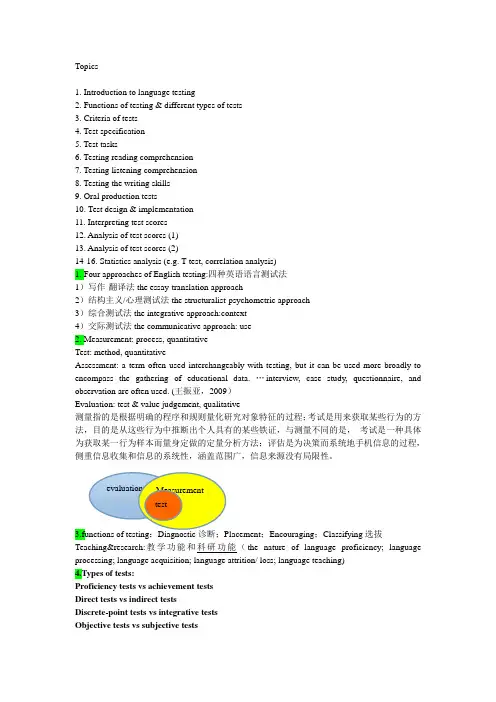
Topics1. Introduction to language testing2. Functions of testing & different types of tests3. Criteria of tests4. Test specification5. Test tasks6. Testing reading comprehension7. Testing listening comprehension8. Testing the writing skills9. Oral production tests10. Test design & implementation11. Interpreting test scores12. Analysis of test scores (1)13. Analysis of test scores (2)14-16. Statistics analysis (e.g. T-test, correlation analysis)1. Four approaches of English testing:四种英语语言测试法1)写作-翻译法the essay-translation approach2)结构主义/心理测试法the structuralist-psychometric approach3)综合测试法the integrative approach:context4)交际测试法the communicative approach: use2. Measurement: process, quantitativeTest: method, quantitativeAssessment: a term often used interchangeably with testing, but it can be used more broadly to encompass the gathering of educational data. …interview, case study, questionnaire, and observation are often used. (王振亚,2009)Evaluation: test & value judgement, qualitative测量指的是根据明确的程序和规则量化研究对象特征的过程;考试是用来获取某些行为的方法,目的是从这些行为中推断出个人具有的某些铁证,与测量不同的是,考试是一种具体为获取某一行为样本而量身定做的定量分析方法;评估是为决策而系统地手机信息的过程,侧重信息收集和信息的系统性,涵盖范围广,信息来源没有局限性。
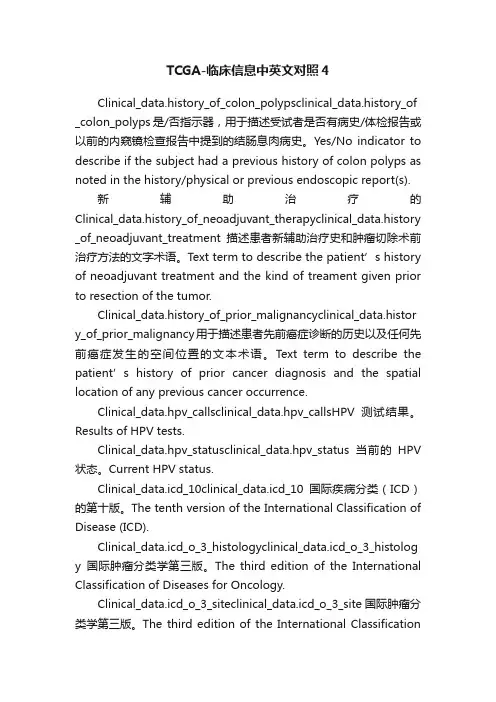
TCGA-临床信息中英文对照4Clinical_data.history_of_colon_polypsclinical_data.history_of _colon_polyps是/否指示器,用于描述受试者是否有病史/体检报告或以前的内窥镜检查报告中提到的结肠息肉病史。
Yes/No indicator to describe if the subject had a previous history of colon polyps as noted in the history/physical or previous endoscopic report(s).新辅助治疗的Clinical_data.history_of_neoadjuvant_therapyclinical_data.history _of_neoadjuvant_treatment描述患者新辅助治疗史和肿瘤切除术前治疗方法的文字术语。
Text term to describe the patien t’s history of neoadjuvant treatment and the kind of treament given prior to resection of the tumor.Clinical_data.history_of_prior_malignancyclinical_data.histor y_of_prior_malignancy用于描述患者先前癌症诊断的历史以及任何先前癌症发生的空间位置的文本术语。
Text term to describe the patient’s h istory of prior cancer diagnosis and the spatial location of any previous cancer occurrence.Clinical_data.hpv_callsclinical_data.hpv_callsHPV测试结果。
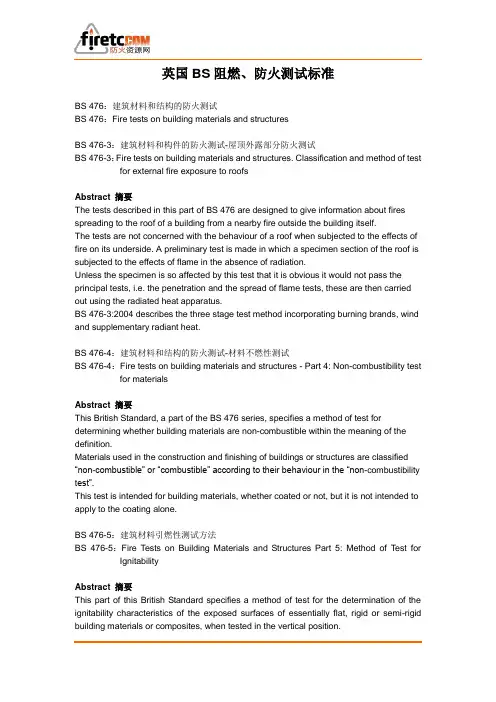
英国BS阻燃、防火测试标准BS 476:建筑材料和结构的防火测试BS 476:Fire tests on building materials and structuresBS 476-3:建筑材料和构件的防火测试-屋顶外露部分防火测试BS 476-3:Fire tests on building materials and structures. Classification and method of test for external fire exposure to roofsAbstract 摘要The tests described in this part of BS 476 are designed to give information about fires spreading to the roof of a building from a nearby fire outside the building itself.The tests are not concerned with the behaviour of a roof when subjected to the effects of fire on its underside. A preliminary test is made in which a specimen section of the roof is subjected to the effects of flame in the absence of radiation.Unless the specimen is so affected by this test that it is obvious it would not pass the principal tests, i.e. the penetration and the spread of flame tests, these are then carried out using the radiated heat apparatus.BS 476-3:2004 describes the three stage test method incorporating burning brands, wind and supplementary radiant heat.BS 476-4:建筑材料和结构的防火测试-材料不燃性测试BS 476-4:Fire tests on building materials and structures - Part 4: Non-combustibility test for materialsAbstract 摘要This British Standard, a part of the BS 476 series, specifies a method of test for determining whether building materials are non-combustible within the meaning of the definition.Materials used in the construction and finishing of buildings or structures are classified “non-combustible” or “combustible” according to their behaviour in the “non-combustibility t est”.This test is intended for building materials, whether coated or not, but it is not intended to apply to the coating alone.BS 476-5:建筑材料引燃性测试方法BS 476-5:Fire Tests on Building Materials and Structures Part 5: Method of Test for IgnitabilityAbstract 摘要This part of this British Standard specifies a method of test for the determination of the ignitability characteristics of the exposed surfaces of essentially flat, rigid or semi-rigid building materials or composites, when tested in the vertical position.BS 476-6:建筑材料和构件的防火测试.第6部分:制品火势蔓延的测试方法BS 476-6:Fire tests on building materials and structures — Part 6: Method of test for fire propagation for productsAbstract 摘要Construction materials, Fire tests, Fire propagation, Testing conditions, Ceiling linings, Ceilings, Wall linings, Walls, Construction systems parts, Test specimens, Specimen preparation, Test equipment, Calibration, Mathematical calculations, Comparative tests, Fire-test classifications, Structural fire protection, Fire safety in buildingsBS 476-7:建筑材料和构件的防火测试.第7部分:测定产品火焰表面蔓延分类的测试方法BS 476-7:Fire Tests on Building Materials and Structures Part 7: Method of Test to Determine the Classification of the Surface Spread of Flame of ProductsAbstract 摘要This British Standard, a part of the BS 476 series, specifies a method of test for measuring the lateral spread of flame along the surface of a specimen of a product orientated in the vertical position under opposed flow conditions, and a classification system based on the rate and extent of the spread of flame.This standard provides data suitable for comparing the end-use performances of essentially flat materials, composites or assemblies, which are used primarily as the exposed surfaces of walls or ceilings.Guidance to operators carrying out this method of test, the effect of thermal characteristics on the performance of assemblies, advice on the construction and preparation of test specimens, and information on the validation of this method are provided in annexes to this standard.BS 476-11:建筑材料和构件的防火测试.第11部分:建筑材料热辐射的判定方法BS 476-11:Fire tests on building materials and structures — Part 11: Method for assessing the heat emission from building materialsAbstract 摘要Fire tests, Construction materials, Heat measurement, Test equipment, Reports, Heat transferBS 476-12:建筑材料和构件的防火测试.第12部分:与火焰直接接触制品可燃性测试方法BS 476-12:Fire tests on building materials and structures — Part 12: Method of test for ignitability of products by direct flame impingementAbstract 摘要Construction materials, Construction systems parts, Fire tests, Ignitability, Flames, Specimen preparation, Vertical, Safety measures, Test equipment, Testing conditions, Test atmospheres, Test specimens, Fire safety in buildings以上资料由防火资源网()防火测试中心整理或发布。
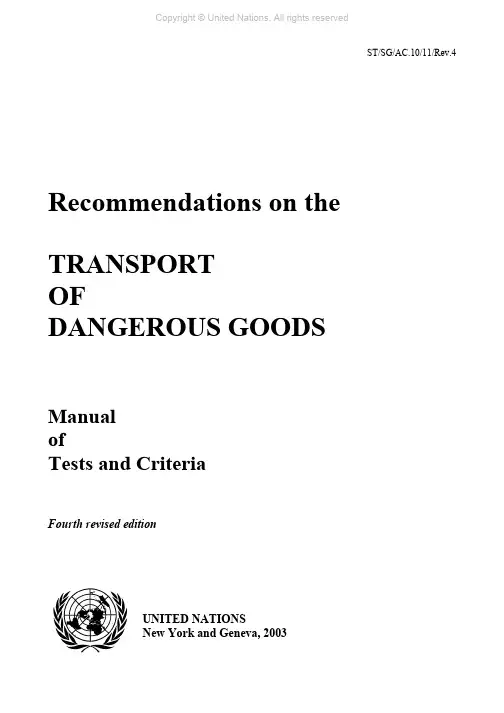
ST/SG/AC.10/11/Rev.4Recommendations on the TRANSPORTOFDANGEROUS GOODSManualofTests and CriteriaFourth revised editionUNITED NATIONSNew York and Geneva, 2003NOTEThe designations employed and the presentation of the material in this publication do not imply the expression of any opinion whatsoever on the part of the Secretariat of the United Nations concerning the legal status of any country, territory, city or area, or of its authorities, or concerning the delimitation of its frontiers or boundaries.ST/SG/AC.10/11/Rev.4Copyright © United Nations, 2003All rights reserved.No part of this publication may, for sales purposes, be reproduced, storedin a retrieval system or transmitted in any form or by any means,electronic, electrostatic, magnetic tape, mechanical, photocopying orotherwise, without prior permission in writing from the United Nations.UNITED NATIONS PUBLICATIONSales No. E.03.VIII.2ISBN 92-1-139087-7FOREWORDThe recommendations in this Manual of Tests and Criteria supplement the "Recommendations on the Transport of Dangerous Goods" and the Model Regulations annexed thereto. They may also be used in relation to the “Globally Harmonized System of Classification and Labelling of Chemicals”. They result from the decisions of the United Nations Committee of Experts on the Transport of Dangerous Goods at its thirteenth (1984), fourteenth (1986), fifteenth (1988), sixteenth (1990), seventeenth (1992), eighteenth (1994), nineteenth (1996), twentieth (1998) and twenty-first (2000) sessions, and those of the Committee of Experts on the Transport of Dangerous Goods and on the Globally Harmonized System of Classification and Labelling of Chemicals at it first (2002) session.This fourth revised edition includes revised provisions for the classification of lithium batteries (sub-section 38.3) adopted by the Committee in 2000 (ST/SG/AC.10/27/Add.2) (already published, together with corrections to the third revised edition as ST/SG/AC.10/11/Rev.3/Amend.1); and new provisions for the classification of ammonium nitrate emulsions (section 18), flammable aerosols (section 31) and substances corrosive to metals (section 37) adopted by the Committee in 2002 (ST/SG/AC.10/29/Add.2).GENERAL TABLE OF CONTENTSSection Page 1. GENERAL INTRODUCTION (Introduction, Layout, Precedence of HazardCharacteristics, Safety, General Conditions for Testing,Recommended Tests and Reporting) (1)PART I: CLASSIFICATION PROCEDURES, TEST METHODS ANDCRITERIA RELATING TO EXPLOSIVES OF CLASS 110. INTRODUCTION TO PART I (Purpose, Scope, Acceptance procedure,Assignment Procedure, Examples of Test Report) (13)11. TEST SERIES 1 (To determine if a substance has explosive properties) (31)12. TEST SERIES 2 (To determine if a substance is too insensitive for inclusionin Class 1) (51)13. TEST SERIES 3 (To determine if a substance is thermally stable and nottoo dangerous to transport in the form in which it was tested) (69)14. TEST SERIES 4 (To determine if an article, packaged article orpackaged substance is too dangerous for transport) (123)15. TEST SERIES 5 (To determine if a substance may be assigned toDivision 1.5) (129)16. TEST SERIES 6 (To assign a substance or article to Division 1.1, 1.21.3 or 1.4 or exclude it from Class 1) (143)17. TEST SERIES 7 (To determine if an article may be assignedto Division 1.6) (155)18. TEST SERIES 8 (To determine if an ammonium nitrate emulsion, suspension or gel,intermediate for blasting explosives (ANE), is insensitive enough for inclusion inDivision 5.1, and to evaluate the suitability for transport in tanks) (177)PART II: CLASSIFICATION PROCEDURES, TEST METHODS AND CRITERIARELATING TO SELF-REACTIVE SUBSTANCES OF DIVISION 4.1AND ORGANIC PEROXIDES OF DIVISION 5.220. INTRODUCTION TO PART II (Purpose, Scope, Preliminary Procedure,Classification Procedure, Example of Test Report) (201)21. TEST SERIES A (To determine if there is propagation of detonation) (213)22. TEST SERIES B (To determine if there is detonation in the package) (229)23. TEST SERIES C (To determine if there is propagation of deflagration) (233)24. TEST SERIES D (To determine if there is rapid deflagration in thepackage) (245)25. TEST SERIES E (To determine the effect of heating under confinement) (249)26 TEST SERIES F (To determine the explosive power) (265)27. TEST SERIES G (To determine if there is thermal explosion inthe package) (289)28. TEST SERIES H (To determine the Self-accelerating DecompositionTemperature) (295)GENERAL TABLE OF CONTENTS (continued)Section Page PART III: CLASSIFICATION PROCEDURES, TEST METHODS AND CRITERIARELATING TO CLASS 3, CLASS 4, DIVISION 5.1 AND CLASS 930. INTRODUCTION TO PART III (Purpose, Scope) (323)31.CLASSIFICATION PROCEDURES, TEST METHODS AND CRITERIARELATING TO FLAMMABLE AEROSOLS OF CLASS 2 (325)32. CLASSIFICATION PROCEDURES, TEST METHODS AND CRITERIARELATING TO LIQUID DESENSITIZED EXPLOSIVES ANDFLAMMABLE LIQUIDS OF CLASS 3 (341)33. CLASSIFICATION PROCEDURES, TEST METHODS AND CRITERIARELATING TO CLASS 4 (351)34. CLASSIFICATION PROCEDURES, TEST METHODS AND CRITERIARELATING TO OXIDIZING SUBSTANCES OF DIVISION 5.1 (369)35. Reserved for classification procedures, test methods and criteriarelating to Class 6 (381)36. Reserved for classification procedures, test methods and criteriarelating to Class 7 (383)37.CLASSIFICATION PROCEDURES, TEST METHODS AND CRITERIARELATING TO SUBSTANCES OF CLASS 8 (385)38. CLASSIFICATION PROCEDURES, TEST METHODS AND CRITERIARELATING TO CLASS 9 (389)APPENDICES (403)Appendix 1 SPECIFICATIONS OF STANDARD DETONATORS (407)Appendix 2 BRUCETON AND SAMPLE COMPARISON METHODS (411)Appendix 3 CAVITATION OF SAMPLES (415)Appendix 4 NATIONAL CONTACTS FOR TEST DETAILS (419)Appendix 5 EXAMPLE OF A TEST METHOD FOR VENT SIZING (421)Appendix 6 SCREENING PROCEDURES (427)SECTION 1GENERAL INTRODUCTION1.1 Introduction1.1.1 The purpose of this text is to present the United Nations schemes for the classification of certain types of dangerous goods and to give descriptions of the test methods and procedures considered to be the most useful for providing competent authorities with the necessary information to arrive at a proper classification of substances and articles for transport. The Manual of Tests and Criteria should be used in conjunction with the latest version of the Recommendations on the Transport of Dangerous Goods (hereafter referred to as the Recommendations) and of the Model Regulations on the Transport of Dangerous Goods annexed to these Recommendations (hereafter referred to as the Model Regulations).1.1.2 It should be noted that the Manual of Tests and Criteria is not a concise formulation of testing procedures that will unerringly lead to a proper classification of products. It therefore assumes competence on the part of the testing authority and leaves responsibility for classification with them. The competent authority has discretion to dispense with certain tests, to vary the details of tests, and to require additional tests when this is justified to obtain a reliable and realistic assessment of the hazard of a product. In some cases, a small scale screening procedure may be used to decide whether or not it is necessary to perform larger scale classification tests. Suitable examples of procedures are given in the introductions to some test series and in Appendix 6.1.2 Layout1.2.1 The classification procedures, test methods and criteria are divided into three parts:Part I: those relating to assignment of explosives to Class 1;Part II: those relating to assignment of self-reactive substances to Division 4.1 and of organic peroxides to Division 5.2;Part III: those relating to assignment of substances or articles to Class 3, Class 4, Division 5.1 or Class 9.Part III contains some classification procedures, test methods and criteria which are also given in the Model Regulations. There are also a number of appendices which give information common to a number of different types of tests, on the National Contacts for Test Details, on an example method for emergency relief vent sizing of portable tanks for the transport of organic peroxides and self-reactive substances and on screening procedures.1.2.2 The methods of test identification are given in Table 1.1.Table 1.1: TEST IDENTIFICATION CODESPart of manual Test series Test type Test number Example of testidentification codeI II IIIl - 8A - HL - T(a), (b), etc.--(i), (ii), etc.a1, 2, etc.1, 2, etc.2 (a) (i)A.lL.la If only one test is given for a test type, the Roman numerals are not used.1.2.3 Each test is given a unique identification code and is edited as follows:Introductionx.1Apparatus and materialsx.2Procedure (including observations to be made and data to be collected)x.3x.4Test criteria and method of assessing resultsExamples of resultsx.5NOTE: Examples of results are not normally given for tests on articles as these are too specific to the article tested and do not allow validation of the test procedure. Results on substances may vary from those given in the "Examples of results" if the physical form, composition, purity etc. of the substance is different. The results given should not be regarded as standard values.Figures x.1, x.2, x.3 etc. (i.e. diagrams of apparatus etc.)NOTE: Unless otherwise indicated, the dimensions given on the diagrams are in millimetres.1.3 Precedence of hazard characteristics1.3.1 The table in2.0.3.3 of Chapter 2.0 of the Model Regulations may be used as a guide in determining the class of a substance, mixture or solution having more than one risk, when it is not named in the Dangerous Goods List in Chapter 3.2 of the Model Regulations. For goods having multiple risks, which are not specifically listed by name in Chapter 3.2 of the Model Regulations, the most stringent packing group denoted to the respective hazard of the goods takes precedence over other packing groups, irrespective of the precedence of hazard table in 2.0.3.3 of Chapter 2.0 of the Model Regulations.1.3.2 The precedence of hazard characteristics of the following are not dealt with in the Precedence of Hazard Table in Chapter2.0 of the Model Regulations, since these primary characteristics always take precedence:Substances and articles of Class 1;Gases of Class 2;Liquid desensitized explosives of Class 3;Self-reactive substances and solid desensitized explosives of Division 4.1;substances of Division 4.2;PyrophoricSubstances of Division 5.2;Substances of Division 6.1 with a Packing Group I inhalation toxicity;Substances of Division 6.2; andMaterial of Class 7.1.3.3 Self-reactive substances, except for type G, giving a positive result in the self-heating test for Division 4.2, should not be classified in Division 4.2 but in Division 4.1 (see paragraph2.4.2.3.1.1 of the Model Regulations). Organic peroxides of type G having properties of another class or division (e.g. UN 3149) should be classified according to the requirements of that class or division.1.4 Safety1.4.1 For the safety of laboratory personnel, the producer or other applicant for classification of a new product should provide all available safety data on the product e.g. the toxicity data.1.4.2 Particularly when explosive properties are suspected, it is essential for the safety of workers that small scale preliminary tests are carried out before attempting to handle larger quantities. This involves tests for determining the sensitiveness of the substance to mechanical stimuli (impact and friction), and to heat and flame.1.4.3 In tests involving initiation of potentially explosive substances or articles, a safe waiting period, prescribed by the test agency, should be observed after initiation.1.4.4 Extra care should be taken when handling samples which have been tested since changes may have occurred rendering the substance more sensitive or unstable. Tested samples should be destroyed as soon as possible after the test.1.5 General conditions for testing1.5.1 The conditions given in the test prescriptions should be followed as closely as possible. If a parameter is not specified in the test prescription then the conditions given here should be applied. Where tolerances are not specified in the test prescription, it is implied that the accuracy is according to the number of decimal places given in any dimension e.g. 1.1 implies 1.05 to 1.15. In cases where conditions during a test deviate from those prescribed, the reason for the deviation should be stated in the report.1.5.2 The composition of the test sample should be as close as possible to the concentration of the substance intended for transport. The contents of active substance(s) and diluent(s) should be specified in the test report with at least an accuracy of ± 2 % by mass. Components which can have a major effect on a test result, such as moisture, should be specified as accurately as possible in the test report.1.5.3 All test materials in contact with the test substance should be such that, as far as possible, they do not affect the test results e.g. catalyse decomposition. In cases where such an effect cannot be excluded, special precautions should be taken to prevent the result being affected, e.g. passivation. The precautions taken should be specified in the test report.1.5.4 The tests should be performed under the conditions (temperature, density etc.) which are representative of the expected circumstances of transport. If the transport conditions are not covered by the test conditions specified, supplementary tests may need to be performed which are specifically designed for the anticipated transport conditions e.g. elevated temperature. Where appropriate, e.g. when the result is particle size dependent, the physical conditions should be specified in the test report.tests1.6 Recommended1.6.1 The manual gives descriptions of tests and criteria used to provide the necessary information to arrive at a proper classification. In some cases, there is more than one test for a particular property. As a result of comparative work with some of these tests, it has been possible to identify one test as the recommended test in a set of equivalent tests. The recommended tests for classifying explosive substances and articles (Part I of the manual) are listed in Table 1.2 and for classifying self-reactive substances and organic peroxides (Part II of the manual) in Table 1.3. All test methods given in Part III of the manual are recommended tests as only one test is given for each property. The other tests in a set are considered to be alternative tests and may continue to be used for classification purposes.1.6.2 As a result of comparative work, some tests have been deleted. However, as some countries maintain databases referenced by the test number, the tests currently given in the test manual have not been renumbered unless existing tests have been assigned to different test types.1.6.3 The aim is to have only one United Nations test, or combination of tests, for each property. However, until the recommended tests have been used more widely, it is not possible to do this in all cases at present.1.6.4 If new tests are proposed for inclusion in the manual, the proposer should be able to provide justification that the new test is a significant improvement on the existing recommended test. In such cases, the new test may be included as an alternative test until it has been tried by laboratories of other countries.Table 1.2: RECOMMENDED TESTS FOR EXPLOSIVES AND EXPLOSIVE ARTICLESTest series TesttypeTestcodeTest name1(a) 1 (a)UN gap test1(b) 1 (b)Koenen test1(c) 1 (c)(i)Time / pressure test2(a) 2 (a)UN gap test2(b) 2 (b)Koenen test2(c) 2 (c)(i)Time / pressure test3(a) 3 (a)(ii)BAM Fallhammer3(b) 3 (b)(i)BAM Friction apparatus3(c) 3 (c)Thermal stability test at 75 °C3(d) 3 (d)Small-scale burning test4(a) 4 (a)Thermal stability test for unpackaged articles and packaged articles4(b) 4 (b) (i)Steel tube drop test for liquids4 (c) 4 (b)(ii)Twelve metre drop test for unpackaged articles, packaged articles andpackaged substances5(a) 5 (a)Cap sensitivity test5(b) 5 (b)(ii)USA DDT test5(c) 5 (c)External fire test for Division 1.56(a) 6 (a)Single package test6(b) 6 (b)Stack test6(c) 6 (c)External fire (bonfire) test7(a)7 (a)EIDS cap test7(b)7 (b)EIDS gap test7(c)7 (c)(ii)Friability test7(d)7 (d) (i)EIDS bullet impact test7(e)7 (e)EIDS external fire test7(f)7 (f)EIDS slow cook-off test7(g)7 (g) 1.6 article external fire test7(h)7 (h) 1.6 article slow cook-off test7(j)7 (j) 1.6 article bullet impact test7(k)7 (k) 1.6 article stack test8 (a) 8(a) Thermal stability test for ANE8 (b) 8(b) ANE gap test8 (c) 8(c)Koenentest8 (d) 8(d) Vented pipe test aa This test is intended for evaluating the suitability for transport in tanks.Table 1.3: RECOMMENDED TESTS FOR SELF-REACTIVE SUBSTANCES AND ORGANIC PEROXIDESTest series Test code Test nameA A.6UN detonation testB B.1Detonation test in packageC C C.1C.2Time/pressure testDeflagration testD D.1Deflagration test in the packageE E E.1E.2Koenen testDutch pressure vessel testF F.4Modified Trauzl testG G.1Thermal explosion test in packageH H H H.1H.2H.4United States SADT test (for packages)Adiabatic storage test (for packages, IBCs and tanks)Heat accumulation storage test (for packages, IBCs and smalltanks)1.7 Reporting1.7.1 Classifications for Chapter 3.2 of the Model Regulations are made on the basis of consideration of data submitted to the Committee by governments, intergovernmental organisations and other international organisations in the form recommended in Figure 1 of the Recommendations. Supplementary data is required for the classification of:Substances and articles of Class 1 (see 10.5);Self-reactive substances of Division 4.1 (see 20.5); andOrganic peroxides of Division 5.2 (see 20.5).1.7.2 Where tests are performed on packaged substances or articles, the test report should contain the quantity of substance or number of articles per package and the type and construction of the packaging.- 5 -。
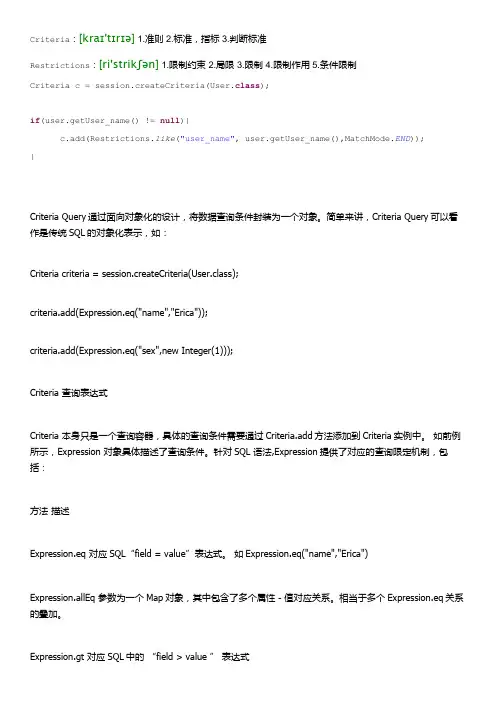
Criteria:[kraɪ'tɪrɪə] 1.准则 2.标准,指标 3.判断标准Restrictions:[ri'strikʃən] 1.限制约束 2.局限 3.限制 4.限制作用 5.条件限制Criteria c = session.createCriteria(User.class);if(user.getUser_name() != null){c.add(Restrictions.like("user_name", user.getUser_name(),MatchMode.END));}Criteria Query通过面向对象化的设计,将数据查询条件封装为一个对象。
简单来讲,Criteria Query可以看作是传统SQL的对象化表示,如:Criteria criteria = session.createCriteria(User.class);criteria.add(Expression.eq("name","Erica"));criteria.add(Expression.eq("sex",new Integer(1)));Criteria 查询表达式Criteria 本身只是一个查询容器,具体的查询条件需要通过Criteria.add方法添加到Criteria实例中。
如前例所示,Expression 对象具体描述了查询条件。
针对SQL 语法,Expression提供了对应的查询限定机制,包括:方法描述Expression.eq 对应SQL“field = value”表达式。
如Expression.eq("name","Erica")Expression.allEq 参数为一个Map对象,其中包含了多个属性-值对应关系。
相当于多个Expression.eq关系的叠加。
Criteria的一些语句范例(方法)一、Criteria的一些基本查询Criteria有一个方法add(“限定条件”),这个方法可以添加限定条件,好得到自己应该要的查询结果;例如:有两个实体类,student和teacher已经有一个Criteria的关于Student 类的实例Criteria crit = session.createCriteria(Student.class);1)在一个班级中要查询姓“王”的学生都有谁,就可以这样:List list = crit.add(Restrictions.like(“name”,”王%”)).list();2)查询年龄在17-20之间的学生:List list = crit.add(Restrictions.between(“age”,new Integer(17),new Integer(20))).list();3)查询没有手机号码的学生:List list = crit.add(Restrictions.isNull(tel)).list();4)查询90后的学生:List list = crit.add(Restrictions.ge(new Date(1990-01-01)).list();5)查询考试分数在前十名的学生(可用于分页查询):List list = crit.addOrder(Order.desc(“grades”)).setFirstResult(0).setMaxResult(10).list();6)查询学生小明的个人信息:crit.add(Restriction.eq(“name”,”小明”)).list().iterator().next();7)查询小明的化学教师的信息:crit.add(Restricrions.eq(“name”,”小明”)).createCriteria(“teacher_id”).add(Restrictions.equ(“subject”,”化学”)).list().iterator().next();8)以上都是先创建session根据session得到Criteria的实体对象(即在线查询),下面来看看离线查询,离线查询用的是DetachedCriteria类,DetachedCriteria类使你在一个session范围之外创建一个查询,并且可以使用任意的Session来执行它。
六月英语四级作文June CET-4 Writing: Tips and Strategies。
As one of the most important English proficiency testsin China, the College English Test (CET) is widely recognized and required by universities and employers. The CET-4, in particular, is a crucial benchmark for college students to demonstrate their English language skills. Asthe June CET-4 is approaching, it is essential for test-takers to prepare well and develop effective strategies to achieve a satisfactory score. In this article, we will provide some tips and strategies for the June CET-4 writing section.1. Understand the requirements and evaluation criteria。
Before starting the writing task, it is essential to read and understand the prompt carefully. The promptusually consists of a topic and some instructions on whatto write. It is crucial to follow the instructions andaddress all the aspects of the topic. In addition, test-takers should be familiar with the evaluation criteria, which usually include coherence, organization, grammar, vocabulary, and sentence structure. It is necessary to pay attention to these criteria and try to meet them as much as possible.2. Plan and organize the essay。
专四2016英语真题作文及解析全文共3篇示例,供读者参考篇12016年专业四级英语考试是一场具有挑战性的考试,其中作文部分是一项十分重要的考核项目。
以下是2016年专四英语真题作文及解析。
作文题目:The Influence of Internet on People's Life作文要求:1. 描述互联网在人们生活中的重要性;2. 讨论互联网对人们生活的影响;3. 你对于互联网给人们的生活带来的积极影响以及如何应对消极影响的看法。
解析:互联网在现代社会中扮演着重要的角色,它极大地便利了人们的生活。
人们可以通过互联网获取各种信息,进行在线购物,进行远程办公等。
互联网的出现大大提高了人们的工作效率和生活质量。
然而,互联网也带来了一些负面影响。
首先,互联网的广泛使用可能导致人们对现实生活的孤立感,过度依赖网络社交。
其次,网络信息的不准确性和虚假性可能误导人们,造成消极影响。
针对这些问题,我认为我们应该做到以下几点。
首先,人们应该明智地使用互联网,不要沉溺于虚拟世界中,要适时与人交流和面对面交流。
其次,我们应该学会分辨网络信息的真伪,不轻易相信一些不经证实的信息。
总的来说,互联网给人们的生活带来了很多便利,但也需要我们警惕其可能带来的消极影响。
只有正确地使用互联网,才能让它真正成为我们生活中的助力而非负担。
以上就是2016年专四英语真题作文及解析。
希望对大家备考有所帮助。
祝大家取得优异的成绩!篇2Title: 2016 TEM-4 English Writing Test Essay and AnalysisIntroduction:The Test for English Majors Grade 4 (TEM-4) is one of the most important English proficiency tests in China, especially for students majoring in English. In 2016, the writing test for TEM-4 included various topics that challenged students to demonstrate their language skills and critical thinking abilities. This essay willprovide an analysis of the 2016 TEM-4 English writing test, focusing on the topics, structure, and scoring criteria.Writing Task 1:The first writing task in the 2016 TEM-4 test required students to write an argumentative essay on the topic of whether social media has a positive or negative impact on society. This topic is relevant and thought-provoking, as social media has become an integral part of modern life. Students were expected to present arguments and examples to support their stance, as well as address counterarguments to show a balanced perspective.Structure:- Introduction: Briefly introduce the topic and state your position.- Body paragraphs: Present arguments and examples to support your position, address counterarguments, and provide a conclusion.- Conclusion: Summarize your main points and restate your position.Scoring criteria:- Clarity of thesis statement- Logical organization of ideas- Use of evidence and examples to support arguments- Addressing counterarguments- Coherence and cohesion- Language accuracy and fluencyWriting Task 2:The second writing task in the 2016 TEM-4 test asked students to write a report on the benefits and challenges of studying abroad. This task required students to analyze the advantages and disadvantages of studying in a foreign country and provide recommendations for students considering studying abroad. Students were expected to use a formal tone and academic language in their reports.Structure:- Introduction: Introduce the topic and provide an overview of the benefits and challenges of studying abroad.- Body paragraphs: Discuss the benefits, challenges, and recommendations for studying abroad.- Conclusion: Summarize the key points and reiterate the importance of studying abroad.Scoring criteria:- Clarity of purpose and audience- Analysis of benefits and challenges- Logical organization of ideas- Recommendations supported by evidence- Language accuracy and formalityConclusion:Overall, the 2016 TEM-4 English writing test provided students with opportunities to demonstrate their critical thinking skills, language proficiency, and writing abilities. By analyzing the topics, structure, and scoring criteria of the writing tasks, students can better prepare for future English proficiency tests and improve their overall writing skills.篇32016专四英语写作真题及解析Part I Writing (30 minutes)Directions: For this part, you are allowed 30 minutes to write a short essay on the topic of Crowdfunding. You should write at least 150 words following the outline given below.1.众筹(crowdfunding)这种集资方式在中国越来越流行2.众筹的优点和缺点3.我的看法CrowdfundingIn recent years, crowdfunding has become increasingly popular in China. Crowdfunding is a method of raising capital through the collective effort of friends, family, customers, and individual investors. It has provided a new way for entrepreneurs, artists, and small businesses to raise funds for their projects or ideas.There are several advantages to crowdfunding. Firstly, it allows entrepreneurs to access funding from a large number of individuals, reducing their dependence on traditional sources of finance such as banks or venture capitalists. This democratization of funding can help to level the playing field for small businesses and startups. Secondly, crowdfunding can also be a valuable marketing tool, as it allows entrepreneurs to engage directly withtheir backers and build a community around their project. This can help to create buzz and generate interest in the project.However, there are also drawbacks to crowdfunding. One of the main concerns is the risk of fraud, as there is often limited oversight of crowdfunding campaigns. In addition, some projects may fail to deliver on their promises, leaving backers with nothing to show for their investment. Furthermore, the sheer number of crowdfunding campaigns can make it difficult for individual projects to stand out and attract attention.In my opinion, crowdfunding is a valuable tool for entrepreneurs and small businesses, but it is important for backers to exercise caution and due diligence when participating in crowdfunding campaigns. By doing research and carefully evaluating projects before investing, backers can help to mitigate the risks associated with crowdfunding. Ultimately, crowdfunding has the potential to revolutionize the way that we fund projects and ideas, but it is important to approach it with a critical eye.。
王蔷英语教学法教程第⼆版Unit15Unit 15 Assessment in language Teaching 重要⼀、Understanding assessmentThe differences between testing, assessment and evaluation:1. Testing:It often takes the ‘pencil and paper’ form and it is usually done at the end of a learning period, such as unit-test, mid-term-test, semester-test etc.2. Assessment:It involves the collecting of information or evidence of a learner’s learning progress and achievement over a period of time for the purposes of improving teaching and learning.3. Evaluation:It involves making an overall judgment about one’s work or a whole school’s work. According to Cameron, it can be concerned with ‘a whole range of issues in and beyond language education: lessons, courses, programs, and skills can all be evaluated.’Evaluation is the most general of the three concepts, for decision-making purpose. Assessment focuses on the learning progress and process-oriented, for the purpose of improving teaching and learning. Test is one instrument of assessment, focusing on the result of learning.⼆、Assessment purposesAssessment in ELT means to discover what the learners know and can do at certain stage of the learning process.A close study of the assessment purposes will make it clear that all the people involved in education have some reasons to consider assessment necessary. They are administrators, teachers, parents and students.1. for administrators:They need to know whether the programs they have planned are working well. The only way to do this is to discover how well the students are doing with their courses.2. for teachers:Teachers put the administrators’ plans into practice. They need to know what has been done and what needs to be done next; what the students already know or can do and what they don’t know or can’t do yet.3. for parents:They are anxious to know what their children are doing in school. Unable to watch their kids in the class, parents value the feedback about their children’s performance from the teachers and the school.4. for students:They need to know what they’ve accomplished, be aware of what they need to work on next, and build up confidence and satisfaction from what they have achieved.三、Methods for assessmentAssessment includes testing but definitely not only testing. Assessment is often divided into summative assessment and formative assessment.1. Summative assessment:Summative assessment is mainly based on testing. It is done mostly at the end of a learning period or the end ofa school year.2. Formative assessment:Formative assessment is based on information collected in the classroom during the teaching process for the purposes of improving teaching and learning, therefore, it is sometimes termed as classroom assessment as well.3. The ways to gather students’ learning information:(1)Teacher’s observationsTeacher’s observations of the learners’ overall performance or achievement can be quite accurate and fair.(2)Continuous assessmentThe final grade given to the student is some kind of combination of the grades the student has received for various assignments during the course.(3)Self-assessment and peer assessmentStudents are able to make quite accurate assessment of their own achievements. With peer-assessment students are involved in assessing each other’s work.(4)Project workProject work requires students to complete a set of tasks designed to explore a certain idea or concept.(5)PortfoliosA portfolio is a purposeful collection of materials assembled over a period of time by a learner to provide evidence of skills, abilities and attitudes related to their study.四、Criteria for assessmentAssessment means to discover how well learners know things or can do things. Depending on different assessment purposes and the stage at which the assessment is made, assessment should be made according to different criteria or references. 1. Different criteria or references of assessment:(1)Criterion-referenced assessmentCriterion-referenced language assessment is based on a fixed standard or a set criterion. The national or local educational authority may have this standard or criterion. A school or several schools in a district may have their standard or set criterion for whatever purposes they might have. A fixed standard is usually the ultimate goal which the students are expected to achieve at the end of the course.(2)Norm-referenced assessmentNorm-referenced assessment is designed to measure how the performance of a particular student or group of students compares with the performance of another student or group of students whose scores are given as the norm. A student’s achievement is therefore interpreted with reference to the achievement of other students or groups of students, rather than to an agreed criterion.(3)Individual-referenced assessmentIndividual-referenced assessment is based on how well the learner is performing relative to his or her own previous performance, or relative to an estimate of his or her individual ability. For example, if a student could only say a few words inEnglish after a few months of the course, and now after another month’s study, he is able to speak with some fluency (although there is some inaccuracy), we can surely say he has made great progress.2. Criteria to assess portfolios:Setting up clear criteria for assessment is very important when introducing the use of portfolios.The criteria for assessing pupil’s portfolio:·Inclusion of all the required entries;·Quality of final products;·Seriousness of revisions;·Depth of reflections;·Layout and design;·Keeping to the time schedule.五、Assessment principlesAssessment should be based on the following principles:①assess authentic use of language in reading, writing, speaking, and listening;②assess literacy and language in a variety of contexts;③assess the environment, the instruction, and the students;④assess processes as well as products;⑤analyze patterns of errors in language and literacy;⑥base assessment on normal developmental patterns and behavior in language and literacy acquisition;⑦clarify and use standards when assessing reading, writing, and content knowledge;⑧involve students and parents, as well as other personnel in the assessment process;⑨make assessment an ongoing part of every day.It is ideal if assessors can follow all these principles. But in reality, it is very difficult to achieve this.六、Tests in assessment1. Drawbacks of using tests for assessment:①A test is often a one-off event which may not necessarily give a fair sample of the learner’s overall proficiency; They are not always valid or reliable;②Tests tend to fragment skills. Most tests test only lower-order thinking skills;③When assessment is solely dependent on test results, teachers tend to begin teaching to the test (washback effect).2. Types of test items:Test items can be designed in various formats. A test whose items are designed in different formats tends to have more validity and reliability than a test that is designed in a single format, for example, multiple-choice format. Below are the most frequently used test formats.(1)Questions & answersStudents are asked to answer questions according to information provided in reading texts or recorded materials. (2)True or false questionsStudents are provided with a set of statements related to the read or heard texts and required to decide whetherthey are true or false according to the texts.(3)Multiple-choice questionsThis form can be used virtually for all language areas, such as reading, listening, vocabulary, grammar, and pronunciation. Usually there are 3—5 choices, one of which is the correct answer, and the rest are distracters. (4)Gap-filling or completionStudents are asked to complete paragraphs or sentences by either filling in words they think are appropriate or choosing the best from the given choices. The test goals can be of grammar, vocabulary or reading comprehension.(5)Matching questionsTraditionally matching is only used for vocabulary tests, i.e. students are asked to match words with their definitions or their synonyms or antonyms. Now matching is used in a great variety of ways.(6)DictationStudents write down exactly what is read to them. The dictated materials can be sentences or short paragraphs.(7)TransformationUsually students are asked to transfer sentences from one pattern to another but keep the original meaning. A similar term for this form is rewriting.(8)TranslationStudents are asked to translate sentences or paragraphs from or into the target language.(9)Essay writingStudents are asked to write an essay on a certain given topic. Usually a set of instructions are given regarding the length, format and topic of the expected essay. Evaluation is based on both the language and the contents of the essay.(10)InterviewInterviews are often used to evaluate oral skills. The testers ask the students questions or ask them to perform some tasks. 3. The role of testing in the classroom:Classroom testing is the topic of this handbook. Although the teacher is primarily concerned with teaching rather than testing, classroom tests play three important roles in the second-language program: they define course objectives, they stimulate student progress, and they evaluate class achievement.(1)Defining course objectives(2)Stimulating student progress(3)Evaluating class achievement4. Types of test: 学硕语⾔学真题⾥考过四种测试类型There are four basic types of language tests: aptitude tests, progress tests, achievement tests, and proficiency tests.(1) The aptitude test (能⼒倾向测试)The aptitude test is conceived as a prognostic measure that indicates whether a student is likely to learn a second language readily. It is generally given before the student begins language study, and may be used to select students for a language course or to place students in sections appropriate to their ability.(2) The progress test(进步测试)The progress test measures how much the student has learned in a specific course of instruction. The tests that the classroom teacher prepares for administration at the end of a unit or end of a semester are progress tests. Their format reflects thevarious components of the curriculum. This hand-book is written specifically to help teachers improve their progress tests and evaluate those which commercial publishers distribute to accompanytheir materials.(3) The achievement test(成绩测试)The achievement test is similar to the progress test in that it measures how much the student has learned in the course of second-language instruction. However, achievement tests are usually not built around one set of teaching materials hut are designed for use with students from a variety of different schools and programs. For example, the afternoon tests of the College Board battery are achievement tests. Dictations given over unfamiliar material may also he considered achievement tests when they are used to compare students across different programs.(4) The proficiency test(⽔平测试)The proficiency test also measures what students have learned, but the aim of the proficiency test is to determine whether this language ability corresponds to specific language requirements. The proficiency tests, in fact, usually report student language ability on a continuum that reflects a predetermined set of categories.(5) Diagnostic test (诊断测试)5. Testing items:When we design a test question, we should focus on the followings:validity(有效性),reliability(可靠性), discrimination(区别性), difficulty(难度), 具体掌握这⼏个的含义。
4可靠性确认Qualification of Optoelectronic Devices4.1 性能Characterization4.1.1 性能测试Characterization TestsR4-2 [106v2] 光电器件应该测试光性能和电性能R4-4 [420] 对于所有器件,在常温下测试的一些参数需要在工作温度的极限条件下测试。
R4-5 [421] 对于可调激光器,需要在最大、最小、和中心工作波长条件下测试参数。
O4-6 [422] 除非出现下列情况,对于集成模块的参数需要在4.4.2(表4-6)中列的三个震动或冲击条件下测试。
如果集成模块显示出对震动和冲击不敏感,则O4-6 [422]将不需要进行。
CR4-7 [423] 所有的器件需要在温度变化率为1°C/minute 的条件下测试性能。
R4-8 [110v2] 在diode和module levels级别里,至少需要20个器件进行特性相关的测试,而在integrated modules 里,则至少需要10个器件进行测试,且都要求没有失效发生。
表4-2的备注:1 May be performed on non-functional devices that are mechanically identical to the functional devices with the exception that any fiber pigtails/boots have been cut off.2 ESD门限测试是破坏性实验。
“0”这里是指当器件加载的ESD测试电压小于ESD的最低可接受电压(500V)时,可接受的失效数。
3 当模块或集成模块的所有组件的ESD门限都大于4000V时,或者器件是铌酸锂调制器等对ESD不敏感的器件时,ESD测试时用此条件。
4 如果集成模块没有施加ESD电压的那些版,这时ESD测试将使用另外一个条件(见3.2.10.2.2)。